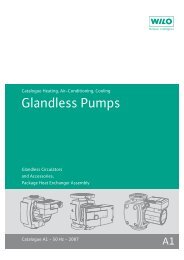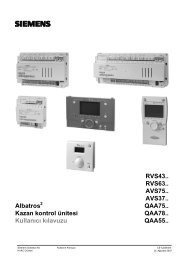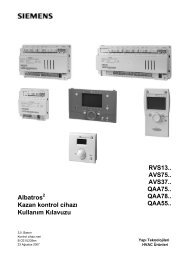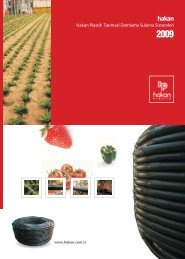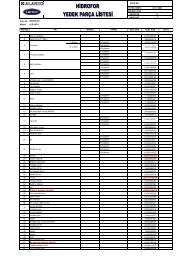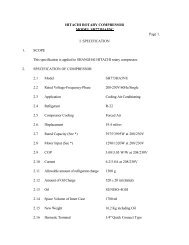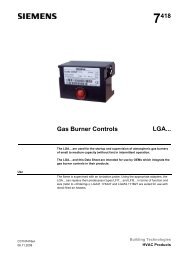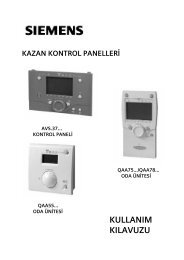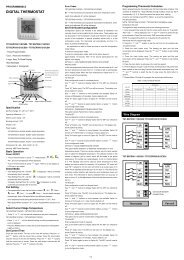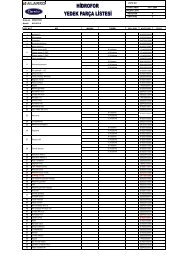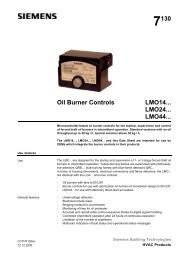A/C Scroll Compressors ZR 90 K4*.....ZR 300 KC*
A/C Scroll Compressors ZR 90 K4*.....ZR 300 KC*
A/C Scroll Compressors ZR 90 K4*.....ZR 300 KC*
You also want an ePaper? Increase the reach of your titles
YUMPU automatically turns print PDFs into web optimized ePapers that Google loves.
A/C <strong>Scroll</strong> <strong>Compressors</strong><br />
<strong>ZR</strong> <strong>90</strong> <strong>K4*</strong>.....<strong>ZR</strong> <strong>300</strong> <strong>KC*</strong><br />
Application Guideline
Index<br />
Page<br />
1 Introduction 3<br />
2 Nomenclature 3<br />
3 Qualified Refrigerants 4<br />
4 Compressor Handling 4<br />
5 Lubrication and Oil Removal 4<br />
6 Accumulators 5<br />
7 Screens 5<br />
8 Crankcase Heaters 6<br />
9 Pumpdown 6<br />
10 Minimum Run Time 6<br />
11 Reversing Valves 7<br />
12 Discharge Temperature Protection 7<br />
13 Electronic Motor Protection 7<br />
14 Protector Functional Test 8<br />
15 Mufflers 9<br />
16 Suction Line Noise and Vibration 9<br />
17 Low Ambient Cut-Out 10<br />
18 Pressure Safety Controls 10<br />
19 Shut-off Sound 11<br />
20 Starting 11<br />
Page<br />
22 Shell Temperature 11<br />
23 Brief Power Interruptions 11<br />
24 Electrical Installation 11<br />
25 Electrical Connections 12<br />
26 Cable Connectors 12<br />
27 Compressor Functional Check 13<br />
28 Excessive Liquid Floodback Tests 13<br />
29 High Potential Testing 14<br />
30 Compressor Mounting 15<br />
31 Installation and Service Brazing Procedure 15<br />
32 Installation System Charging Procedure 16<br />
33 Suction and Discharge Fittings 16<br />
34 Shut-off Valves and Adaptors 17<br />
35 Unbrazing System Components 18<br />
36 Compressor Replacement 18<br />
37 Start-up of a New or Replacement Compressor 18<br />
38 Rotation Direction 18<br />
39 R 407 C Characteristics 18<br />
40 Application Envelopes 20<br />
41 Application Diagram 21<br />
21 Deep Vacuum Operation 11<br />
C6.2.2/0701/E 2
1 Introduction<br />
This bulletin describes the operating characteristics, design features, and application requirements for<br />
7.5 to 25 HP A/C <strong>Scroll</strong> <strong>Compressors</strong> in the range from <strong>ZR</strong> <strong>90</strong> K3 to <strong>ZR</strong> <strong>300</strong> KC. This family of scroll<br />
compressors is characterized by the pilot duty motor protection system that uses internal sensors and<br />
an external electronic module to protect the compressor against motor overheating and excessive discharge<br />
temperature. For additional information, please refer to the “Product Catalogue“ or to the<br />
“Copeland Selection Software” accessible from the Copeland website at www.ecopeland.com. There<br />
are several operating characteristics and design features described below that are different from those<br />
of the smaller Copeland <strong>Scroll</strong> compressor models. These guidelines are not meant to replace the system<br />
expertise available from system manufacturers.<br />
2 Nomenclature<br />
The model numbers of the Copeland <strong>Scroll</strong> compressors include the approximate nominal 60 Hz capacity<br />
at standard operating conditions. An example would be the <strong>ZR</strong><strong>90</strong>K3-TWD, which has approximately<br />
<strong>90</strong>,000 Btu/hr cooling capacity at the ARI high temperature air conditioning rating point when<br />
operated on 60 Hz. The letter “K” in the 5 th place of the model number indicates that the number preceding<br />
it is to be multiplied by 1000, “M” by 10,000. Note that the same compressor will have approximately<br />
5/6 of this capacity or 75000 Btu/hr when operated on 50 Hz current.<br />
Model Designation<br />
1 - compressor family: Z = <strong>Scroll</strong><br />
2 - application range: R = high/medium temperature<br />
3 - nominal capacity [BTU/h] @ 60 Hz and ARI conditions (*see below) using multipliers<br />
"K" for 1000 and "M" for 10 000<br />
4 - model variation<br />
5 - oil type: E=POE oil, no value = mineral oil<br />
6 - motor version: TWC (230V/3/60 Hz), TWD (400V/460V/3/50/60 Hz), TWE (500V/575V/3/50/60 Hz)<br />
TW7 (380V/3/60 Hz)<br />
7 - bill of material number: 522: Brazing connection, 120/240 V module (<strong>ZR</strong><strong>90</strong>K3*/<strong>ZR</strong><strong>300</strong><strong>KC*</strong>)<br />
568: Brazing connection, 24 V AC module (<strong>ZR</strong><strong>90</strong>K3* to <strong>ZR</strong>19M3*)<br />
524: Brazing connection, 24 V AC module (<strong>ZR</strong>250<strong>KC*</strong>/<strong>ZR</strong><strong>300</strong><strong>KC*</strong>)<br />
551: Rotalock connection, 120/240 V module (<strong>ZR</strong><strong>90</strong>K3* to <strong>ZR</strong>19M3*)<br />
523: Rotalock connection, 120/240 V module (<strong>ZR</strong>250<strong>KC*</strong>/<strong>ZR</strong><strong>300</strong><strong>KC*</strong>)<br />
561: Rotalock connection, 24 V AC module (<strong>ZR</strong><strong>90</strong>K3* to <strong>ZR</strong>19M3*)<br />
525: Rotalock connection, 24 V AC module (<strong>ZR</strong>250<strong>KC*</strong>/<strong>ZR</strong><strong>300</strong><strong>KC*</strong>)<br />
*ARI-Conditions:<br />
7,2 °C evaporating temperature 8,3 K liquid subcooling<br />
54,4 °C condensing temperature 35 °C ambient temperature<br />
11 K suction gas superheat<br />
C6.2.2/0701/E 3
3 Qualified Refrigerants<br />
R407C has been qualified as a replacement for R22 for the compressor models <strong>ZR</strong> <strong>90</strong> K3E ... <strong>ZR</strong><strong>300</strong><br />
KCE. R134a is qualified for the models <strong>ZR</strong> <strong>90</strong> K3E…<strong>ZR</strong> 19 M3E. The application envelopes of each<br />
refrigerant are shown in Section 40.<br />
4 Compressor Handling<br />
It is recommended that the plugs in the compressor line connections be left in place until the compressor<br />
is set into the unit. This reduces the chance of contaminants and moisture getting into the compressor<br />
especially if the compressor is charged with the more hygroscopic POE oil. If the compressor has<br />
two lifting tabs, both must be used for lifting. The discharge connection plug should be removed first<br />
before pulling the suction connection plug to allow the dry air pressure inside the compressor to escape.<br />
Pulling the plugs in this sequence prevents oil mist from coating the suction tube making brazing<br />
difficult. The copper-coated steel suction tube should be cleaned before brazing (see Fig. 13). No object<br />
(e.g. a swaging tool) should be inserted deeper than 50 mm into the suction tube or it might damage<br />
the suction screen.<br />
5 Lubrication and Oil Removal<br />
The compressor is supplied with an initial oil charge. The standard oil charge for use with refrigerants<br />
R407C and R134a is a polyolester (POE) lubricant Copeland 3MA (32 cSt). In the field the oil level<br />
could be topped up with ICI Emkarate RL 32 CF or Mobil EAL Arctic 22 CC, if 3MA is not available. In<br />
R22 applications Suniso 3GS is used. Suniso 3GS is compatible with Texaco WF 32 and Fuchs KM.<br />
These oils may be used if an addition is required in the field.<br />
When a compressor is exchanged in the field it is possible that a major portion of the oil from the replaced<br />
compressor may still be in the system. While this may not affect the reliability of the replacement<br />
compressor, the extra oil will add to rotor drag and increase power usage. To remove this excess oil an<br />
access valve has been added to the lower shell of the compressor. The compressor should be run for<br />
10 minutes, shut down and the access valve opened until oil is somewhere between 1 / 4 to 1 / 3 of the<br />
sight glass. This operation should be repeated at least twice to make sure the proper oil level has been<br />
achieved.<br />
Fig. 1:<br />
Absorption of moisture in ester oil in comparison to mineral oil in [ppm] by weight<br />
at 25°C and 50% relative humidity. h = hours.<br />
One disadvantage of POE is that it is far more hygroscopic than mineral oil (Fig.1). Only brief exposure<br />
to ambient air is needed for POE to absorb sufficient moisture to make it unacceptable for use in a refrigeration<br />
system. Since POE holds moisture more readily than mineral oil it is more difficult to remove<br />
it through the use of vacuum. <strong>Compressors</strong> supplied by Copeland contain oil with a low moisture content,<br />
and this may rise during the system assembling process. Therefore it is recommended that a<br />
C6.2.2/0701/E 4
properly sized filter-drier is installed in all POE systems. This will maintain the moisture level in the oil to<br />
less than 50 ppm. If oil is charged into a system it is recommended to charge systems with POE containing<br />
no more than 50 ppm moisture content. If the moisture content of the oil in a refrigeration system<br />
reaches unacceptable high levels, corrosion and copper plating may occur.<br />
The system should be evacuated down to 0.3 mbar or lower. If there is uncertainty, as to the moisture<br />
content in the system, an oil sample should be taken and tested for moisture. Sight glass/moisture indicators<br />
currently available can be used with the HFC refrigerants and lubricants; however, the moisture<br />
indicator will just show the moisture contents of the refrigerant. The actual moisture level of POE would<br />
be higher than the sight glass specifies. This is a result of the high hygroscopicity of the POE oil. Oil<br />
samples would have to be taken from the system and analyzed to determine the actual moisture content<br />
of the lubricant.<br />
6 Accumulators<br />
Due to the Copeland <strong>Scroll</strong>’s inherent ability to handle liquid<br />
refrigerant in flooded start and defrost cycle operation, an<br />
accumulator is not be required for durability in most systems,<br />
especially those systems designed with thermostatic expansion<br />
valves. However, large volumes of liquid refrigerant which<br />
repeatedly flood back to the compressor during normal off cycles<br />
or excessive liquid refrigerant floodback during defrost or varying<br />
loads, no matter what the system charge is, can dilute the oil. As<br />
a result, bearings are inadequately lubricated and wear may<br />
Fig. 2: Suction Accumulator occur. To test for these conditions see the section entitled<br />
Excessive Liquid Floodback Tests at Section 28. If an<br />
accumulator must be used, an oil return<br />
orifice size in the range 2 mm 2 is<br />
recommended. A large-area protective<br />
screen no finer than 30 x 30 mesh (0.6<br />
mm 2 openings) is required to protect this<br />
small orifice from plugging with system<br />
debris. Tests have shown that a small<br />
screen with a fine mesh can easily become<br />
plugged causing oil starvation to the<br />
compressor bearings. Accumulators are a<br />
standard item in air to air heat pumps and<br />
are used even when a thermostatic<br />
expansion valve is used to meter<br />
refrigerant in the heating mode. During low<br />
Fig. 3: Bottom Shell Temperature<br />
ambient conditions the oil returning from<br />
the outdoor coil will be very viscous and<br />
difficult to return through the accumulator if the expansion valve is working properly by maintaining superheat.<br />
To prevent slow oil return it may be possible to remove the accumulator from systems that use<br />
expansion valves in heating. To determine if the accumulator can be removed a defrost test must be<br />
done at an outdoor ambient of around 0 °C in a high humidity environment to ensure that excessive<br />
liquid does not flood back to the compressor during reversing valve operation, especially when coming<br />
out of defrost. Excessive flood back occurs when the sump temperature drops below the safe operation<br />
line shown in Fig. 3 for more than 10 seconds.<br />
7 Screens<br />
The use of screens finer than 30 x 30 mesh (0,6 mm 2 openings) anywhere in the system is not recommended.<br />
Field experience has shown that finer mesh screens used to protect thermal expansion<br />
valves, capillary tubes, or accumulators can become temporarily or permanently plugged with normal<br />
system debris and block the flow of either oil or refrigerant to the compressor. Such blockage can result<br />
in compressor failure.<br />
C6.2.2/0701/E 5
8 Crankcase Heaters<br />
The crankcase heater must be mounted below the oil<br />
removal valve located on the bottom shell. The crankcase<br />
heater must remain energized during compressor off<br />
cycles.<br />
The initial start in the field is a very critical period for any<br />
compressor because all load bearing surfaces are new and<br />
require a short break-in period to carry high loads under<br />
adverse conditions. The crankcase heater must be<br />
turned on a minimum of 12 hours prior to starting the<br />
compressor. This will prevent oil dilution and bearing<br />
Fig. 4: Crankcase Heater Location<br />
stress on initial start up. If it is not feasible to turn on the<br />
crankcase heater 12 hours in advance of starting the<br />
compressor, then use one of the techniques listed below to prevent possible flooded-start damage to<br />
the compressor:<br />
1) Direct a 500 watt heat lamp or other safe heat source (do not use torch) at the lower shell of the<br />
compressor for approximately 30 minutes to boil off any liquid refrigerant prior to starting; or<br />
2) Bump start the compressor by manually energizing the compressor contactor for about one second.<br />
Wait five seconds and again manually energize compressor for one second. Repeat this cycle<br />
several times until the liquid in the shell has been boiled off and the compressor can be safely<br />
started and run continuously.<br />
Due to the Compliant <strong>Scroll</strong>’s inherent ability to handle liquid refrigerant in flooded conditions, no crankcase<br />
heater is required when the system charge does not exceed following values:<br />
· 7,7 kg for <strong>ZR</strong> <strong>90</strong> K3* ... <strong>ZR</strong> 19 M3*<br />
· 11,3 kg for <strong>ZR</strong> 250 <strong>KC*</strong><br />
· 13,6 kg for <strong>ZR</strong> <strong>300</strong> <strong>KC*</strong><br />
A crankcase heater is needed to drive out excessive amounts of refrigerant that have migrated into the<br />
shell during standstill periods and no accumulator is piped to provide free liquid drainage during the off<br />
cycle as shown in Fig. 2. Please also see Section 28. For correct mounting location of such a heater<br />
please see Fig. 4.<br />
9 Pumpdown<br />
Recycling pumpdown for control of refrigerant migration may be used instead of, or in conjunction with,<br />
a crankcase heater when the compressor is located so that cold air blowing over the compressor<br />
makes the crankcase heater ineffective. The <strong>Scroll</strong> compressor discharge check valve is designed for<br />
low leak back and will allow the use of recycling pump down without the addition of an external check<br />
valve. The low pressure control cut-in and cut-out settings have to be reviewed since a relatively large<br />
volume of gas will re-expand from the high side of the compressor into the low side on shut down. A<br />
one time pump down at the end of a run cycle is not recommended since refrigerant can still migrate<br />
into the compressor after a long shut down. If a one time pump down is used a crankcase heater must<br />
be installed.<br />
10 Minimum Run Time<br />
There is no set answer to how often scroll compressors can be started and stopped in an hour, since it<br />
is highly dependent on system configuration. There is no minimum off time, because the scrolls start<br />
unloaded, even if the system has unbalanced pressures. The most critical consideration is the minimum<br />
run time required to return oil to the compressor after startup. This is easily determined since these<br />
compressors are equipped with a sight glass. The minimum on time becomes the time required for oil<br />
lost on compressor startup to return to the compressor sump and restore a normal level in the sight<br />
C6.2.2/0701/E 6
glass. Cycling the compressor for a shorter time than this, for instance to maintain very tight temperature<br />
control can result in progressive loss of oil and damage to the compressor.<br />
11 Reversing Valves<br />
Since Copeland <strong>Scroll</strong> compressors have a very high volumetric efficiency, their displacements are<br />
lower than those of comparable capacity reciprocating compressors. As a result, Copeland recommends<br />
that the capacity rating on reversing valves be no more than 2 times the nominal capacity of the<br />
compressor with which it will be used. This will ensure proper operation of the reversing valve under all<br />
operating conditions.<br />
The reversing valve solenoid should be wired so that the valve does not reverse when the system is<br />
shut off by the operating thermostat in the heating or cooling mode. If the valve is allowed to reverse at<br />
system shut-off, suction and discharge pressures are reversed to the compressor. This results in pressures<br />
equalizing through the compressor which can cause the compressor to slowly rotate until the<br />
pressures equalize. This condition does not affect compressor durability but can cause unexpected<br />
sound after the compressor is turned off.<br />
12 Discharge Temperature Protection<br />
A thermistor with a nominal response temperature of 140 °C is located in the discharge port of the fixed<br />
scroll (Fig. 5). Excessive discharge temperature will cause the electronic protector module to trip (see<br />
also Section 13). The discharge gas sensor is wired in series with the motor thermistor chain.<br />
Fig. 5: Internal Discharge Temperature Protection<br />
13 Electronic Motor Protection<br />
The electronic motor protection system as used in all <strong>ZR</strong> <strong>90</strong> K3* ... <strong>ZR</strong> <strong>300</strong> <strong>KC*</strong> models is identified by<br />
a “W” as the center letter in the motor code. This system utilizes the temperature dependent resistance<br />
of thermistors (also called PTC-resistances) to read the winding temperature. A chain of four thermistors<br />
connected in series is embedded in the motor windings so that the temperature of the thermistors<br />
can follow the winding temperature with little inertia. An electronic module is required to process the resistance<br />
values and trip a control relay depending on the thermistor resistance. The characteristic gradient<br />
of a thermistor resistance curve is shown in Fig. 6. The resistance curve can be designed for different<br />
operating points, the nominal response temperature (NAT), e.g. 80°C, 100°C, 140°C, and must<br />
comply with the tolerances laid out in the standard DIN 44081.<br />
C6.2.2/0701/E 7
Module<br />
Protector Specifications :<br />
Type:<br />
Kriwan INT 69 SC/ Carel<br />
Voltage:<br />
24 V AC; 230 V AC,120/240 V AC<br />
Control Rating:<br />
60 VA, 25 A Inrush <strong>300</strong>/375 VA 25/15 A Inrush<br />
Normal PTC resistance: 250 to 1000 Ohms<br />
Trip resistance: >4500 Ohm +/- 20%<br />
Reset resistance:<br />
- Reconnect the disconnected thermistor line. If the compressor is now switched on the motor must<br />
start.<br />
Protector Fault Diagnosis:<br />
If the motor does not start-up during the functional check, this indicates a disturbance in operation:<br />
- Switch off power.<br />
- Check the connection of the thermistor leads in the terminal box and at the protection module for possible<br />
loose connections and check the connection cable for possible breakage.<br />
- The resistance of the thermistor chain shall be measured in a cold condition, i.e. after the motor has<br />
sufficiently cooled down.<br />
Caution: Use maximum measuring voltage of 3 V!<br />
In doing so, the thermistor leads at terminals S1 and S2 of the module shall be disconnected and measured<br />
between the leads. Resistance must be between 150 and 1250 ohms.<br />
If the thermistor chain has a higher resistance (2750 ohms or greater) the motor temperature is still too<br />
high and it has to be allowed to cool.<br />
If the resistor is 0 ohms, the compressor has to be exchanged due to shorted sensor circuit. ¥ ohms<br />
indicates an open sensor circuit and the compressor has to be replaced.<br />
If no defect is located in the thermistor chain or there is no loose contact or conductor breakage, the<br />
module shall be checked. Then the control connections at M1 and M2 have to be removed (Caution!<br />
Switch off voltage supply first!) and check the switching conditions by an ohmmeter or signal buzzer:<br />
- short-cut the already disconnected thermistor contactors S1 and S2 and switch on the voltage supply;<br />
the relay must switch; connection established between contactors M1 and M2<br />
-remove the jumper between S1 and S2, the relay must switch off; no connection between contactors<br />
M1 and M2<br />
- shortcut the contactors S1 and S2 again, the relay remains switched off; no connection between contactors<br />
M1 and M2<br />
- switch off the voltage supply for approximately 4 sec and switch it on again, the relay must switch on<br />
now; connection between contactors M1 and M2<br />
If one of the above conditions is not met, the module is defective and has to be exchanged.<br />
Note: The power should be switched off between the tests, in order to avoid short circuits and accidental<br />
touching of contacts. The function of the module should be tested each time the fuse in the control<br />
circuit breaks the power supply. This makes sure that the contacts did not stick.<br />
15 Mufflers<br />
Flow through Copeland <strong>Scroll</strong> <strong>Compressors</strong> is semi-continuous with relatively low pulsation. External<br />
mufflers, which used to be applied to piston compressors, may not be required for Copeland <strong>Scroll</strong>. Because<br />
of variability between systems, however, individual system tests should be performed to verify<br />
acceptability of sound performance. When no testing is performed, mufflers are recommended in heat<br />
pumps. A hollow shell muffler will work quite well. The muffler should be located a minimum of 15 cm to<br />
a maximum of 45 cm from the compressor for most effective operation. The further the muffler is placed<br />
from the compressor within these ranges, the more effective it may be. If adequate attenuation is not<br />
achieved, use a muffler with a larger cross-sectional area to inlet-area ratio. The ratio should be a<br />
minimum of 20:1 with a 30:1 ratio recommended. The muffler should be from four to 10-15 cm long.<br />
16 Suction Line Noise and Vibration<br />
Copeland <strong>Scroll</strong> compressors inherently have low sound and vibration characteristics. However, the<br />
sound and vibration characteristics differ in some respects from those of reciprocating compressors. In<br />
rare instances, these could result in unexpected sound complaints.<br />
One vibration characteristic of the scroll compressor may result in a low level “beat” frequency that may<br />
be detected as noise coming along the suction line into the building under some conditions. Elimination<br />
of the “beat” can be achieved by attenuating the contributing frequency. The most important frequency<br />
to avoid is the power supply line frequency for three phase compressors. The scroll compressor makes<br />
C6.2.2/0701/E 9
Fig. 8: Suction Tube Design<br />
both a rocking and torsional motion, and enough flexibility must<br />
be provided in the suction line to prevent vibration transmission<br />
into any lines attached to the unit. In a split system the most<br />
important goal is to ensure minimal vibration in all directions at<br />
the service valve to avoid transmitting vibrations to the<br />
structure to which the lines are fastened. A second difference<br />
of the Copeland <strong>Scroll</strong> is that under some conditions the<br />
normal rotational starting motion of the compressor can<br />
transmit an “impact” noise along the suction line. This may be<br />
particularly pronounced in three phase models due to their<br />
inherently higher starting torque. This phenomenon, like the<br />
one described previously, also results from the lack of internal<br />
suspension, and can be easily avoided by using standard<br />
suction line isolation techniques.<br />
The sound phenomena described above are not usually associated with heat pump systems because<br />
of the isolation and attenuation provided by the reversing valve and tubing bends.<br />
17 Low Ambient Cut-Out<br />
Low ambient cutouts are not required to limit heat pump operation. However, the discharge temperature<br />
must be limited to 135°C or below otherwise the motor protection may trip.<br />
18 Pressure Safety Controls<br />
High Pressure Control: Because these compressors do not have an internal pressure relief valve, a<br />
high pressure control with a maximum cut out setting of 28,8 bar must be used in the system. The high<br />
pressure control should have a manual reset feature for the highest level of system protection.<br />
Low Pressure Control: A low-pressure control is highly recommended for loss of charge protection.<br />
A cutout setting no lower than 2 bar for air conditioning and 0.5 bar for heat pumps is recommended.<br />
Even though these compressors have an internal discharge temperature sensor, loss of system charge<br />
etc. will result in overheating and recycling of the motor protector. Prolonged operation in this manner<br />
could result in oil pump out and eventual bearing failure.<br />
Operation near 0,5 bar (-32°C saturated suction temperature) is clearly outside the approved operating<br />
envelope of the compressor shown in Fig. 16. However, heat pumps in some geographical areas have<br />
to operate in this range because of the low ambient temperatures. This is acceptable as long as the<br />
condensing temperature is not above 32°C and the resulting discharge temperature is below 135°C.<br />
Some liquid floodback to the compressor under these conditions can help keep the discharge temperature<br />
under control. Certain conditions may cause even the 0.5 bar low-pressure control to cause<br />
nuisance trips. These could be temporary suction blockage during reversing valve operation; or lack of<br />
liquid pressure available to the metering device upon startup in heating. For this reason the lowpressure<br />
control can be moved to the liquid line where it won’t be subjected to momentary low suction<br />
pressures that can cause nuisance trips. An alternative is to keep the low-pressure control in the suction<br />
line and provide a 60-second (maximum) low-pressure time delay that ignores a signal from the<br />
low-pressure control and allows the compressor to continue operating.<br />
The low-pressure cutout, if installed in the suction line to the compressor, can provide additional protection<br />
against a TXV failed in the closed position, outdoor fan failure in heating, a closed liquid line or<br />
suction line service valve, or a blocked liquid line screen, filter, orifice, or TXV. All of these may starve<br />
the compressor for refrigerant and may result in compressor failure. The low-pressure cut out should<br />
have a manual reset feature for the highest level of system protection.<br />
C6.2.2/0701/E 10
19 Shut-off Sound<br />
Since Copeland <strong>Scroll</strong> compressors are also excellent gas expanders, they may run backward for a<br />
brief period at shutoff as the internal pressures equalize.<br />
A low mass, disc-type check valve in the discharge tube of the compressor prevents high pressure gas<br />
entering the compressor after shut down. Additionally there is a disk-type valve mounted on the fixed<br />
<strong>Scroll</strong> that effectively eliminates reverse rotation and allows pressure equalization within the compressor<br />
via a small bleed hole. Momentary reversal of direction of the scrolls has no effect on compressor<br />
durability and is entirely normal. Development testing should include a review of the shut-off sound for<br />
acceptability in a particular system.<br />
20 Starting<br />
During the very brief start-up, a short metallic sound is audible, resulting from initial contacting of the<br />
spirals and is normal. Due to the design of the Compliant <strong>Scroll</strong>, the internal compression components<br />
always start unloaded even if system pressures are not balanced. In addition, since internal compressor<br />
pressures are always balanced at startup, low-voltage starting characteristics are excellent for Compliant<br />
<strong>Scroll</strong> compressors.<br />
21 Deep Vacuum Operation<br />
Copeland <strong>Scroll</strong> compressors (as with any refrigerant compressor) should never be used to<br />
evacuate a refrigeration or air conditioning system. The scroll compressor can be used to pump<br />
down refrigerant in a unit as long as the pressures remain within the operating envelope shown in Fig.<br />
16. Low suction pressures will result in overheating of the scrolls and permanent damage to the compressor<br />
drive bearing. An internal protection device unloads and stops the compressor pumping when<br />
the pressure ratio exceeds approximately 10.<br />
22 Shell Temperature<br />
Certain types of system failures, such as condenser or evaporator fan blockage or loss of charge, may<br />
cause the top shell and discharge line to briefly but repeatedly reach temperatures above 177ºC as the<br />
compressor cycles on its internal protection devices. Care must be taken to ensure that wiring or other<br />
materials, which could be damaged by these temperatures, do not come in contact with these potentially<br />
hot areas.<br />
23 Brief Power Interruptions<br />
No time delay is required on three phase models to prevent reverse rotation due to power interruptions.<br />
The torque of the motor is strong enough to assure proper rotation under all starting circumstances.<br />
24 Electrical Installation<br />
Independently from the internal motor protection, fuses have to be installed before the compressor. Selection<br />
of fuses has to be carried out according to VDE 0635 or DIN 57635 or IEC 269-1 or EN 60-269-<br />
1.<br />
Motor insulation material class is “H” for models <strong>ZR</strong> <strong>90</strong> K3 ... <strong>ZR</strong> <strong>300</strong> KC according to IEC 34-18-1, EN<br />
0530, VDE 0530 or DIN 57530.<br />
The Fusite connections are marked as in Fig. 9. Recommended wiring diagram is shown in Fig. 10.<br />
C6.2.2/0701/E 11
25 Electrical Connections<br />
The orientation of the electrical connections on the<br />
Copeland <strong>Scroll</strong> compressors is shown in Fig. 9 and is also<br />
shown on the wiring diagram inside the terminal box cover.<br />
The screw terminals used on this compressor should be<br />
fastened with a torque of 2.5 to 2.6 Nm.<br />
Fig. 9: Motor Terminal Connections<br />
A1<br />
B1<br />
F1<br />
F3<br />
F4<br />
K1<br />
R2<br />
S1<br />
Y1<br />
motor protection module<br />
room thermostat<br />
fuse<br />
high-pressure switch<br />
low-pressure switch<br />
contactor<br />
crankcase heater<br />
auxiliary switch<br />
liquid line solenoid valve<br />
Fig. 10: Control Circuit<br />
26 Cable Connectors<br />
Model TW* Module<br />
<strong>ZR</strong> <strong>90</strong> B/C A<br />
<strong>ZR</strong> 11 B/C A<br />
<strong>ZR</strong> 12 B/C A<br />
<strong>ZR</strong> 16 B/C A<br />
<strong>ZR</strong> 19 B/C A<br />
<strong>ZR</strong> 250 B/C A<br />
<strong>ZR</strong> <strong>300</strong> B/C A<br />
Fig. 11: Cable Connectors<br />
A Flag receptacle B Ring Tongue C Spade<br />
C6.2.2/0701/E 12
The previous table lists recommended types of cable connectors to be used for the various electric terminals<br />
of the compressors and the motor protection module. “A” and “B” must fit 1/4" or 6.3 mm tab sizes.<br />
“C” is to be selected for #10 studs.<br />
Cable sizes are to be selected according to DIN ISO 0100, IEC 364 or national regulations.<br />
27 Compressor Functional Check<br />
A functional compressor test with the suction service valve closed to check how low the compressor will<br />
pull suction pressure is not a good indication of how well a compressor is performing. Such a test will<br />
damage a scroll compressor. The following diagnostic procedure should be used to evaluate whether<br />
a Copeland <strong>Scroll</strong> compressor is working properly.<br />
1. Proper voltage to the unit should be verified.<br />
2. The normal checks of motor winding continuity and short to ground should be made to determine if<br />
an internal motor short or ground fault has developed. If the protector has opened, the compressor<br />
must be allowed to cool sufficiently to allow it to reset.<br />
3. Proper indoor and outdoor blower/fan operation should be verified.<br />
4. With service gauges connected to suction and discharge pressure fittings, turn on the compressor.<br />
If suction pressure falls below normal levels, the system is either low on charge or there is a flow<br />
blockage in the system.<br />
5. If suction pressure does not drop and discharge pressure does not rise to normal levels, reverse<br />
any two of the compressor power leads and reapply power to make sure compressor was not wired<br />
to run in reverse direction. If pressures still do not move to normal values, either the reversing valve<br />
(if so equipped) or the compressor is faulty. Reconnect the compressor leads as originally configured<br />
and use normal diagnostic procedures to check operation of the reversing valve.<br />
6. To test if the compressor is pumping properly, the compressor current draw must be compared to<br />
published compressor performance curves using the operating pressures and voltage of the system.<br />
If the average measured current deviates more than ±15% from published values, a faulty<br />
compressor may be indicated. A current imbalance exceeding 15% of the average on the three<br />
phases may indicate a voltage imbalance and should be investigated further.<br />
7. Before replacing or returning a compressor: Be certain that the compressor is actually defective.<br />
As a minimum, recheck a compressor returned from the field in the shop or depot for winding<br />
resistance and ability to start before returning. More than one-third of compressors returned to<br />
Copeland for warranty analysis are determined to have nothing found wrong. They were misdiagnosed<br />
in the field as being defective. Replacing working compressors unnecessarily costs<br />
everyone.<br />
28 Excessive Liquid Floodback Tests<br />
The following tests are for those system configurations and charge levels identified in Section 8 that<br />
need special testing to verify exemption from need of an accumulator. Fig. 3 applies only during floodback,<br />
not when the suction gas is superheated, and must be used to determine the effectiveness of an<br />
accumulator. The compressor sump temperature during any unit test where flood back occurs must<br />
remain within the "safe zone" shown in Fig. 3.<br />
To test for excessive continuous liquid refrigerant floodback, it is necessary to operate the system<br />
in a test room at conditions where steady state floodback may occur (low ambient heating operation).<br />
Thermocouples should be attached with glue or solder to the center of the bottom shell and to the suction<br />
and discharge lines approximately 15 cm from the shell. These thermocouples should be insulated<br />
from the ambient air with Permagum ® or other thermal insulation to be able to record true shell and line<br />
temperatures. If the system is designed to be field charged, it should be overcharged by 15% in this test<br />
to simulate overcharging commonly found in field installations.<br />
C6.2.2/0701/E 13
The system should be operated at an indoor temperature of 21°C and outdoor temperature extremes (-<br />
18°C or lower in heating) to produce floodback conditions. The compressor suction and discharge pressures<br />
and temperatures as well as the sump temperature should be recorded. The system should be<br />
allowed to frost up for several hours (disabling the defrost control and spraying water on the outdoor<br />
coil may be necessary) to cause the saturated suction temperature to fall to below minus 23°C. The<br />
compressor sump temperature must remain above the sump temperature shown in Fig. 3 or design<br />
changes must be made to reduce the amount of floodback. If an accumulator is used, an oil return orifice<br />
size of 1.8 – 2.3 mm is recommended. Increasing indoor coil volume, increasing outdoor air flow,<br />
reducing refrigerant charge, decreasing capillary or orifice diameter, and adding a charge compensator<br />
can also be used to reduce excessive continuous liquid refrigerant floodback.<br />
To test for repeated excessive liquid floodback during normal system off-cycles perform the “Field<br />
Application Test’’. Obtain a sample compressor with a side sight tube to measure liquid level in the<br />
compressor. Set the system up in a configuration with the indoor unit elevated several feet above the<br />
outdoor unit with 8 m of connecting tubing and no traps between the indoor and outdoor units. If the<br />
system is designed to be field charged, the system should be overcharged by 15% in this test to simulate<br />
overcharging commonly found in field installations. Operate the system in the cooling mode at the<br />
outdoor ambients, on/off cycle times, and number of cycles specified in the table below. Record the<br />
height of the liquid in the compressor at the start of each on cycle, any protector trips, or any compressor<br />
stalls during each test. Review the results with Copeland Application Engineering to determine if an<br />
accumulator is required for the application. The criteria for pass/fail is whether the liquid level is above<br />
the compressor suction connection. Liquid levels higher than these allow any compressor oil floating on<br />
top of the refrigerant to be ingested by the scrolls and pumped out of the compressor on startup, a hazardous<br />
situation.<br />
Field Application Test:<br />
Outdoor ambient (°C): 29 35 40<br />
System on-time (minutes): 7 14 54<br />
System off-time (minutes): 13 8 6<br />
Number of on/off cycles: 5 5 4<br />
To prevent flooded start damage on three phase <strong>Scroll</strong> compressors due to off cycle migration, the accumulator<br />
may be configured on some systems to allow free drainage from the compressor to the accumulator<br />
during the off cycle (please see Fig. 2).<br />
When this configuration is not possible, a crankcase heater is required.<br />
29 High Potential Testing<br />
Copeland subjects all <strong>Scroll</strong> compressors to a high voltage test after final assembly. This is carried out<br />
according to EN 0530 or VDE 0530 part 1.<br />
Since high voltage tests lead to premature aging of the winding insulation we do not recommend additional<br />
tests of that nature.<br />
If it has to be done for any reason disconnect all electronic devices (e.g. motor protection module, fan<br />
speed control, etc.) prior to testing. The test voltage of 1000 V plus twice the nominal voltage is applied<br />
for 1 - 4 seconds between motor winding (each one of the phases) and the compressor shell: The maximum<br />
leak current limit is approximately 10 mA. Repeated tests have to be performed at lower voltages.<br />
Caution: Do not carry out high voltage or insulation tests if the compressor housing is under vacuum.<br />
Compliant <strong>Scroll</strong> compressors are configured with the motor down and the pumping components at the<br />
top of the shell. As a result, the motor can be immersed in refrigerant to a greater extent than hermetic<br />
reciprocating compressors when liquid refrigerant is present in the shell. In this respect, the scroll is<br />
more like semi-hermetics (which have horizontal motors partially submerged in oil and refrigerant).<br />
When Compliant <strong>Scroll</strong> compressors are high potential tested with liquid refrigerant in the shell they can<br />
show higher levels of leakage current than compressors with the motor on top because of the higher<br />
electrical conductivity of liquid refrigerant than refrigerant vapour and oil. However, this phenomenon<br />
C6.2.2/0701/E 14
can occur with any compressor when the motor is immersed in refrigerant. The levels of current leakage<br />
do not present any safety issue. To lower the current leakage reading the system should be operated<br />
for a brief period of time to redistribute the refrigerant to a more normal configuration and the system<br />
high potential tested again.<br />
30 Installation<br />
Four vibration absorber grommets are supplied with each compressor (see Fig.12). They dampen the<br />
start-up surge of the compressor and prevent sounds and vibrations from being transmitted to the compressor<br />
base during operation to a large extent. The metal sleeve inside is intended as a guide to hold<br />
the grommet in place. It is not designed as a load-bearing member, and excessive torquing can crush<br />
the sleeve. Its inner diameter is approximately 8.5 mm to fit e.g. an M8 screw. The mounting torque<br />
should be 13 ± 1 Nm. It is critically important that the grommet is not compressed. A clearance space of<br />
approximately 2-mm between the bottom of the washer and the top of the grommet spacer is recommended<br />
(see Fig. 12).<br />
If the compressors are mounted on a Tandem or used in parallel, then the hard mountings (bolt M 9<br />
5/16”) as described on Fig.12 are recommended. The mounting torque should be 27 ± 1 Nm. It is possible<br />
to deliver these hard mounting parts as a kit, or on request to deliver the compressor with these<br />
parts instead of the rubber grommets.<br />
Fig. 12: Mounting Parts<br />
Rubber Mounts<br />
31 Installation and Service Brazing Procedure<br />
Compliant <strong>Scroll</strong> compressors have copper plated steel suction and discharge tubes. These tubes are<br />
far more robust and less prone to leaks than copper tubes used on other compressors. Due to the different<br />
thermal properties of steel and copper, brazing procedures may have to be changed from those<br />
commonly used. For brazing of the tubes see Fig. 13 and the following procedures.<br />
Since the discharge spud contains a check valve, care must be taken not to overheat it as well as to<br />
prevent brazing material to flow into it.<br />
Fig. 13: Suction Tube Brazing<br />
Fig. 13 shows the proper procedures for brazing the<br />
suction and discharge lines to a scroll compressor. It<br />
is important to flow nitrogen through the system while<br />
brazing all joints during the system assembly<br />
process. Nitrogen displaces the air and prevents the<br />
formation of copper oxides in the system. If allowed<br />
to form, the copper oxide flakes can later be swept<br />
through the system and block screens such as those<br />
protecting capillary tubes, thermal expansion valves,<br />
and accumulator oil return holes. The blockage –<br />
whether it be of oil or refrigerant – is capable of doing<br />
damage resulting in compressor failure.<br />
• The copper-coated steel tubes on scroll compressors can be brazed in approximately the same<br />
manner as any copper tube.<br />
C6.2.2/0701/E 15
Recommended brazing materials: Any silfos material is recommended, preferably with a minimum<br />
of 5% silver.<br />
However, 0% silver is acceptable.<br />
• Be sure tube fitting inner diameter and tube outer diameter are clean prior to assembly.<br />
• Using a double-tipped torch apply heat in area 1.<br />
• As the tube approaches brazing temperature, move the torch flame to area 2.<br />
• Heat area 2 until braze temperature is attained, moving the torch up and down and rotating<br />
around the tube as necessary to heat the tube evenly. Add braze material to the joint while<br />
moving the torch around the joint to flow braze<br />
material around the circumference.<br />
• After the braze material flows around the joint, move the torch to heat area 3. This will draw the<br />
braze material down into the joint. The time spent heating area 3 should be minimal.<br />
• As with any brazed joint, overheating may be detrimental to the final result.<br />
To disconnect:<br />
• Heat joint areas 2 and 3 slowly and uniformly until the braze material softens and the tube can<br />
be pulled out of the fitting.<br />
To reconnect:<br />
• Recommended brazing materials: Silfos with minimum 5% silver or silver braze used on other<br />
compressors. Due to the different thermal properties of steel and copper, brazing procedures<br />
may have to be changed from those commonly used. For brazing of the tubes see Fig. 13 and<br />
the following procedures.<br />
Since the discharge stub contains a check valve, care must be taken not to overheat it as well<br />
as to prevent brazing material to flow into it.<br />
32 Installation System Charging Procedure<br />
Because scrolls have discharge check valves, systems should be charged on both the high and low<br />
side simultaneously to assure refrigerant pressure is present in the compressor before it is tested or<br />
operated. The majority of the charge should be placed in the high side of the system to prevent bearing<br />
washout during first-time start on the assembly line. It is best to charge only vapor into the low side of<br />
the system.<br />
Do not operate compressor without enough system charge to maintain at least 0.5 bar suction<br />
pressure. Do not operate with a restricted suction. Do not operate with the low pressure cut-out<br />
jumpered.<br />
Allowing pressure to drop below 0.5 bar for more than a few seconds may overheat scrolls and<br />
cause early drive bearing damage. Do not use compressor to test opening setpoint of high<br />
pressure cutout. Bearings are susceptible to damage before they have had several hours of<br />
normal running for proper break in.<br />
33 Suction and Discharge Fittings<br />
Torque [Nm]<br />
Rotalock 3/4"-16UNF 40 - 50<br />
Rotalock 1"1/4-12UNF 100-110<br />
Rotalock 1"3/4-12UNF 170-180<br />
Rotalock 2"1/4-12UNF 1<strong>90</strong>-200<br />
Flange w. M16 bolts 102 - 113<br />
Sight Glass 25 - 25.5<br />
Mounting Bolts 5/16", M 9 27 max.<br />
The <strong>Scroll</strong> compressors are available with stub tube or<br />
a combination Rotalock connections and flanged connections.<br />
The stub tube version has copper plated<br />
steel suction and discharge fittings. These fittings are<br />
far more rugged than copper fittings used on other<br />
compressors. Due to the different thermal properties of<br />
steel and copper, brazing procedures may have to be<br />
changed from those commonly used. See Fig. 13 for<br />
assembly line and field brazing procedures. The table<br />
below contains torque values for those compressors<br />
with valve connections.<br />
C6.2.2/0701/E 16
34 Shut-off Valves and Adaptors<br />
(1) - pressure control connection<br />
(2) - gauge connection<br />
A<br />
B<br />
C<br />
Fig. 14: Shut-off Valves and Adaptors<br />
The <strong>Scroll</strong> compressors can be delivered with brazing connections (BOM 522) or in Rotalock connection<br />
(BOM 551).<br />
Rotalock type shut-off valves can fit compressors with Rotalock connections or brazed connection (by<br />
the mean of Rotalock adaptors “C”). Rotalock-shut-off valves are available for the suction as well as the<br />
discharge side (see Spare Parts List “<strong>ZR</strong>”).<br />
Using adaptor “A” and “B” in either straight or angled form provides a way to convert a Rotalock into a<br />
brazing connection (see Spare Parts List “<strong>ZR</strong>”).<br />
For proper torque’s, which have to be applied see table in Section 33.<br />
35 Unbrazing System Components<br />
Caution! Before opening a system it is important to remove all refrigerant from both the high and low<br />
side. If the refrigerant charge is removed from a scroll-equipped unit by bleeding the high side only, it is<br />
possible for the scrolls to seal, preventing pressure equalization through the compressor. This may<br />
leave the low side shell and suction line tubing pressurized. If a brazing torch is then applied to the low<br />
side while the low side shell and suction line contains pressure, the pressurized refrigerant and oil mixture<br />
could ignite when it escapes and contacts the brazing flame. To prevent this occurrence, it is important<br />
to check both the high and low side with manifold gauges before unbrazing. Instructions should<br />
be provided in appropriate product literature and assembly (line repair) areas. If compressor removal is<br />
required, the compressor should be cut out of system rather than unbrazed. See Fig. 13 for proper<br />
compressor removal procedure.<br />
36 Compressor Replacement<br />
In the case of a motor burn, the majority of contaminated oil will be removed with the compressor. The<br />
rest of the oil is cleaned through use of suction and liquid line filter dryers. A 100% activated alumina<br />
suction filter drier is recommended but must be removed after 72 hours. It is highly recommended<br />
that the suction accumulator be replaced if the system contains one. This is because the accu-<br />
C6.2.2/0701/E 17
mulator oil return orifice or screen may be plugged with debris or may become plugged shortly after a<br />
compressor failure. This will result in starvation of oil to the replacement compressor and a second failure.<br />
When a single compressor or tandem is exchanged in the field it is possible that a major portion of<br />
the oil may still be in the system. While this may not affect the reliability of the replacement compressor,<br />
the extra oil will add to rotor drag and increase power usage. See Section 5 on Lubrication and Oil<br />
Removal.<br />
See Section 33 for Rotalock valve, flange fittings, sight glass, and mounting bolt torque values.<br />
37 Start-up of a New or Replacement Compressor<br />
It is good service practice, when charging a system, to charge liquid refrigerant into the high side only<br />
and charge the low side of the system with vapor only. It is not good for any compressor to have liquid<br />
refrigerant dumped from a refrigerant cylinder into the crankcase of the compressor. Do not start the<br />
compressor while the system is in a deep vacuum. Internal arcing may occur when a scroll compressor<br />
is started in a vacuum.<br />
Do not operate compressor without enough system charge to maintain at least 0.5 bar suction<br />
pressure. Do not operate with a restricted suction. Do not operate with the low-pressure cutout<br />
jumpered.<br />
A minimum suction pressure of 1.75 bar must be maintained during charging. Allowing pressure to<br />
drop below 0.5 bar for more than a few seconds may overheat scrolls and cause early drive bearing<br />
damage. Never install a system in the field and leave it unattended when it has no charge, a holding<br />
charge, or with the service valves closed without securely locking out the system. This will prevent unauthorized<br />
personnel from accidentally operating the system and potentially ruining the compressor by<br />
operating with no refrigerant flow.<br />
38 Rotation Direction<br />
<strong>Scroll</strong> compressors, like several other types of compressors, will only compress in one rotational direction.<br />
Direction of rotation is not an issue with single phase compressors since they will always start and<br />
run in the proper direction. Three phase compressors will rotate in either direction depending upon<br />
phasing of the power. Since there is a 50-50 chance of connecting power in such a way as to cause<br />
rotation in the reverse direction, it is important to include notices and instructions in appropriate<br />
locations on the equipment to ensure proper rotation direction when the system is installed and<br />
operated.<br />
Observing that suction pressure drops and discharge pressure rises when the compressor is energized<br />
makes verification of proper rotation direction. There is no negative impact on durability caused by operating<br />
three phase Copeland <strong>Scroll</strong> compressors in the reversed direction for a short period of time<br />
(under one hour) but oil may be lost. Oil loss can be prevented during reverse rotation if the tubing is<br />
routed at least 15 cm above the compressor. After several minutes of operation in reverse, the compressor's<br />
protection system will trip due to high motor temperature. The systems operator will notice a<br />
lack of cooling. However, if allowed to repeatedly restart and run in reverse without correcting the situation,<br />
the compressor will be permanently damaged.<br />
All three phase scroll compressors are identically wired internally. Therefore, once the correct phasing<br />
is determined for a specific system or installation, connecting properly phased power leads to the identified<br />
compressor terminals will insure proper rotation direction.<br />
39 R 407C Characteristics<br />
<strong>Compressors</strong> designed for operation with HFC refrigerants are factory supplied with one of the approved<br />
oils and are suitably identified. They also can be used with HCFC R22. An “E” is added to the<br />
version figure, e.g. <strong>ZR</strong> 19 M3 becomes <strong>ZR</strong> 19 M3E. Different from single component, azeotropic and<br />
near azeotropic refrigerants, the zeotropic R 407* blends are characterized by its relatively large tem-<br />
C6.2.2/0701/E 18
Fig. 15: Temperature Glide<br />
tc1 dew point } condensing at<br />
t c2 boiling point } p v2 = constant<br />
t02 dew point } evaporating at<br />
t01 boiling point } pv2 = constant<br />
pv1 evaporating pressure<br />
tex<br />
t cm<br />
t0m<br />
pv2<br />
tv1<br />
temperature after expansion valve<br />
mean condensing temperature<br />
mean evaporating temperature<br />
condensing pressure<br />
suction gas temperature at pv1=constant<br />
perature glide. Therefore, certain influences on system design, service and maintenance need to be<br />
considered. The composition of liquid and vapour of a zeotropic blend is different when both liquid and<br />
vapour are present. Therefore it is important that charging is carried out in the liquid phase only. Please<br />
also see the refrigerant manufacturer’s instructions. If a leak occurs there could be a change in composition<br />
of the refrigerant remaining in the system. Large changes in composition can result in decreasing<br />
superheat at the expansion valve leading to liquid returning to the compressor.<br />
Another characteristic of significant composition change can be the appearance of sudden “hunting” of<br />
the expansion valve. Tests by R 407C manufacturers have shown that recharging with the original refrigerant<br />
can typically restore satisfactory system operation simply. If it does not result in satisfactory<br />
system operation, it is recommended to analyse the refrigerant composition in the system prior to replacing<br />
the entire system charge. Working with zeotropic blends requires an understanding of the effect<br />
of temperature glide shown in Fig. 15.<br />
Evaporation at constant pressure takes place with the temperature of the refrigerant increasing from t ex<br />
to t o2 and condensation takes place with a falling temperature from t c1 to t c2 . Thus the terms “evaporating<br />
temperature” and “condensing temperature” must be redefined. High glide causes considerable<br />
temperature differences within the heat exchangers. Similarly, clear definitions for “superheating” and<br />
“subcooling” are needed. Such new definitions are also necessary in order to ensure accurate comparisons<br />
of performance against other azeotropic or near azeotropic refrigerants. Evaporating temperature<br />
is defined as the mean temperature (t om ) between the dew-point temperature (t o2 ) resulting from constant<br />
suction pressure (p v1 ) and the temperature at which the refrigerant enters the evaporator (t ex ).<br />
Condensing temperature is defined as the mean temperature (t cm ) between the dew-point temperature<br />
(t c1 ) resulting from constant discharge pressure (p v2 ) and the boiling-point temperature (t c2 ) of the refrigerant.<br />
The superheating of the suction gas is then calculated as the difference in temperature at the compressor<br />
inlet (t v1 ) and the dew-point temperature (t o2 ) of the refrigerant at suction pressure (p v1 ). It is essential<br />
that these definitions be followed when adjusting the superheat setting of expansion valves.<br />
Liquid subcooling is calculated as the difference between actual liquid temperature and the bubble point<br />
temperature (t c2 ) of the refrigerant at discharge pressure (p v2 ).<br />
The definitions presented here are based on those specified by the Air- Conditioning and Refrigeration<br />
Institute (ARI) as part of their Alternative Refrigerants Evaluation Program (AREP). These definitions<br />
C6.2.2/0701/E 19
are used to provide performance comparison with R 22. System designers normally use data based on<br />
the dew point temperatures as specified in EN 12<strong>90</strong>0. With the Copeland Selection Software version 4<br />
and above performance data sheets for both mid point and dew point definitions are available.<br />
It is essential that the glide of R 407 refrigerant blends are given careful consideration when adjusting<br />
pressure controls. Furthermore, it is crucial to consider the effect of pressure losses on glide when sizing<br />
heat exchangers. Pressure losses effectively increase glide significantly in the system. Failure to<br />
consider this in heat energy balance calculations will likely result in undersizing heat exchangers and<br />
other system components. These effects are especially apparent when operating a system near the limits<br />
of its application range.<br />
40 Application Envelopes<br />
10 K Suction Superheat<br />
Fig. 16: Operating Envelopes<br />
25 °C Suction Return Gas Temperature<br />
C6.2.2/0701/E 20
41 Application Diagram<br />
Start at A/C or H/P depending on your application and follow the chart to see if you need additions or<br />
tests on your system.<br />
Fig. 17: Application Diagram<br />
If you have any questions about the above, please contact your local Copeland Sales Office.<br />
C6.2.2/0701/E 21



